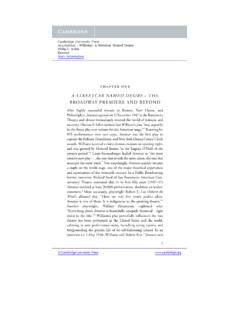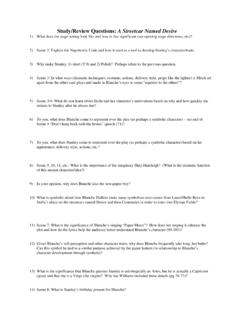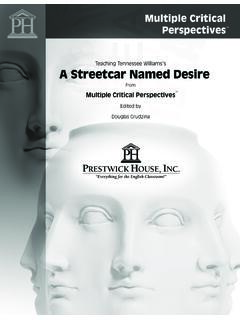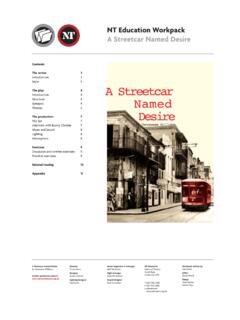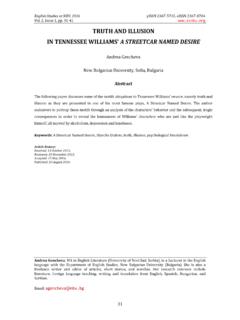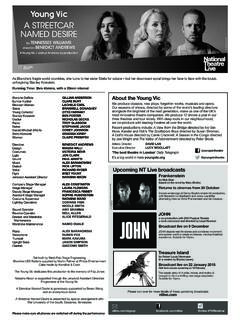Transcription of CRITICISM ON A STREETCAR NAMED DESIRE A …
1 Cercles 10 (2004)Bak, J. S. CRITICISM on A STREETCAR NAMED DESIRE : a bibliographic Survey, 1947-2003 ,Cercles 10 (2004) : ON A STREETCAR NAMED DESIREA bibliographic Survey, 1947-2003 JOHN S. BAKU niversit de Nancy A STREETCAR NAMED DESIRE opened at the Ethel Barrymore Theater on3 December 1947, it stirred up controversy overnight. The play met withrave reviews in the following morning s papers, like that from BrooksAtkinson who called it a quietly woven study of intangibles andTennessee Williams a genuinely poetic playwright whose knowledge ofpeople is honest and thorough [First Night, 42]. In the days ahead, JosephWood Krutch in Nation, Kappo Phelan in Commonweal, John Chapman in theNew York Daily News, John Mason Brown in The Saturday Review, and IrwinShaw in The New Republic all sounded similar praise for Williams and forStreetcar.
2 The play was not impervious to negative reviews, however, asThomas Adler points out in his monograph The Moth and the Lantern,What criticisms the early reviewers did register centered on threeissues: the potentially shocking nature of Williams s material, theseemingly loose way in which he structured it, and the apparentlypessimistic stance he took toward human existence. [Adler, 11]George Jean Nathan, for instance, complained of the play s unpleasant nature, calling it The Glands Menagerie [Nathan, 14], and Mary McCarthy,satirizing Williams s use of symbolism and flowery rhetoric, said Williamswould have been better off writing a wonderful little comic epic, TheStruggle for the Bathroom [McCarthy, 358]. For the most part, though,author and play were critically acclaimed and commercially remains the most intriguing and the most frequently analyzed ofWilliams following is a bibliographic essay digesting much of that theatricand academic CRITICISM devoted to STREETCAR since its debut.
3 Working intandem with, and not opposition to, other bibliographic essays of its kind onStreetcar,1 this essay attempts to provide a comprehensive understanding ofthe main issues that have bothered, troubled, or stumped critics over theyears, issues whose own evolutions should be understood specifically as abyproduct of the changing needs of the academic community itself over theyears. To make the abundant and varied CRITICISM on the play moreaccessible, I have tried to classify these different studies into groups which, I 1 See especially S. Alan CHESLER, A STREETCAR NAMED DESIRE : Twenty-Five Years ofCriticism, Notes on Mississippi Writers, 7 (1973), 44-53; Thomas P. ADLER, A STREETCAR NamedDesire: The Moth and the Lantern, Boston: Twayne, 1990, 10-15; and Philip C. KOLIN, TennesseeWilliams: A Guide to Research and Performance, Westport, CT: Greenwood, 1998, 51-79.
4 Forcontemporary condensations of the various critical renderings, see also Felicia HardisonLONDR , A STREETCAR Running Fifty Years, 45-66, in Matthew C. ROUDAN (ed.), TheCambridge Companion to Tennessee Williams, Cambridge: Cambridge University Press, 10 / 4feel, draw the essential lines of demarcation between how the play has beenvariously interpreted in the last half century. Beginning first with acomparison of the formalist social/psychological readings that interrogatethe problematic of meaning in the play, the essay next explores thecompeting interpretations of that resultant ambiguity, concluding with abrief survey of the recent trend to import feminist, queer, and CulturalStudies paradigms to the play s analysis. Though most of the books andarticles cited within this essay cannot be entirely reduced to just oneparticular idea, I have tried to remain as faithful as possible to the authors defining theses, even if those theses tend to place them in more than oneparticular camp or school of critical s journeyman plays, those he wrote for the Mummers in or for Professor Mabie at the University of Iowa in the 1930s,readily fluctuated between social agitprops, like those he had hoped wouldwin him favor with Chicago s WPA Federal Writers Project, andexpressionistic dreamplays.
5 Which fed his poetic needs for a plastic the early Williams could easily be categorized as both a socialdramatist and a Freudian one the playwright of both Not about Nightingalesand Battle of Angels critics who were at first confused by STREETCAR shermeneutics sought to classify the play either as Williams s socialcommentary on a post-FDR America (or a post-Reconstructionist one, forthat matter) or as a psychological study of a fragile mind s struggle tonegotiate nostalgia with reality (one not too distant from his experienceswith the dementia of his sister Rose). STREETCAR as Social DramaThough a substantial number of critics believe STREETCAR to be essentially asocial drama, few have found themselves in concert in defining what kind ofsocial drama Williams s play most resembles. The first school argues thatBlanche and Stanley represent archetypes of cultures or species.
6 From thisperspective, Eric Bentley and Roger Boxill call STREETCAR a social-historicaldrama [Bentley, 402; Boxill, 79]. Thus Stanley and Blanche s clash is nothuman against human but rather species against species. Three branches ofthis critical school of social dramatization find STREETCAR to be a textbookrepresentation of Strindbergian and Chekhovian Naturalism, of NietzscheanApollonian/Dionysian dichotomy, or of Darwinian natural selection. Asecond school, however, focuses on Blanche and Stanley as uniqueindividuals and not as types, with the audience acting as voyeurs of theirpersonal war. This school can similarly be divided into three branches: thosewho see STREETCAR as a study of Lawrentian blood knowledge, of hero versusantihero, and of villain versus Wood Krutch has made the claim in both The American DramaSince 1918 and Modernism in Modern Drama that he had heard third-handwhat Williams said about the meaning of STREETCAR : You had better look outor the apes will take over [American Drama, 331; Modernism, 129].
7 Krutchfinds in this naturalistic determinism the thesis of most modern (pre-1950)American drama. He sums up half a century s dramatic fiction thus,John S. Bak / 5 The thesis which from the very beginning I have been attempting toexpound might be summed up in such a way as to include a phrasefrom Williams s alleged comment. That is, a break with the past asradical as that which much modern thought and much modern dramaseems to advocate unintentionally prepares the way for the apes totake over. [ Modernism, 129-130]From this understanding, Krutch argues that STREETCAR is a sort of semi-surrealist version of the Strindbergian submission to destructive obsessions [ Modernism, 124].Several critics have also alluded to this naturalistic struggle forcultural hegemony, though dropping the Strindberg label at times. Weeksafter the first performance, for instance, Irwin Shaw said STREETCAR waswritten with a triumphantly heightened naturalism [Miller, 45].
8 Equally,John Gassner, in his landmark College English essay of 1948 TennesseeWilliams: Dramatist of Frustration, calls STREETCAR a naturalistic drama [Gassner, 6]. Joan Templeton, like Thomas E. Porter, Pnina Rafailovich,Joseph K. Davis, and Durant da Ponte, also writes about the cultural clashesbetween Stanley and Blanche. Building upon Cash s Cavalier thesis, Templeton argues that Blanche, through her own epic fornications, is justas responsible for her fall as the Old South is for its own demise. Althoughthe Strindberg label is missing in Templeton, as it is in all of these argumentshere, its essence is still Bernard in Philip Kolin s A STREETCAR NAMED DESIRE : APlaywrights Forum describes an identical naturalism in STREETCAR , not inStrindbergian but in Chekhovian terms. Bernard finds STREETCAR , as JohnGassner did earlier in his A Study in Ambiguity [Bogard & Oliver, 377],similar to The Cherry Orchard.
9 Both plays portray the decline of one cultureand the subsequent rise of another. Here, the serf Lopahin s rise to economicpower presages Stanley Kowalski s ascension in the New South; and inBlanche, the aristocratic but bourgeois Old South has fallen victim to thenatural evolution (some say revolution) of the rise of the proletariat. JacobH. Adler defends this Chekhovian view in his Tennessee Williams s South:The Culture and the Power (revised from his earlier essay, The Rose andthe Fox ), where he argues that all of Williams s plays set in the South dealwith the confrontation between culture and power, though in STREETCAR thatis not all that is at work,What is primary is story and people as they are, as they inevitably are;what is secondary is Blanche and the others as representative of theculture-power dichotomy and the southern dilemma; what is tertiary[.]
10 ] is Blanche as representative of the sensitive individual lost in thecomplex, impersonal modern world. [Tharpe, 40]Constance Drake, in Blanche Dubois: A Re-Evaluation, agrees with JacobAdler s assessment (the Chekhovian connection) and finds Williams presenting the pessimistic view of modern man destroying the tenderaspects of love. [..] And, in Blanche s refusal to submit, she is beingportrayed as the last representative of a sensitive, gentle love whose defeat isto be lamented [Drake, 59].Cercles 10 / 6 None, though, has had as much influence on this naturalistic theory asElia Kazan, STREETCAR s first, and arguably most influential, director. From hisprivate director s notebook, published for the first time in 1976, Kazaninforms us as to where his sympathies lay. Although he identifies withBlanche s plight, his support is with Stanley.

